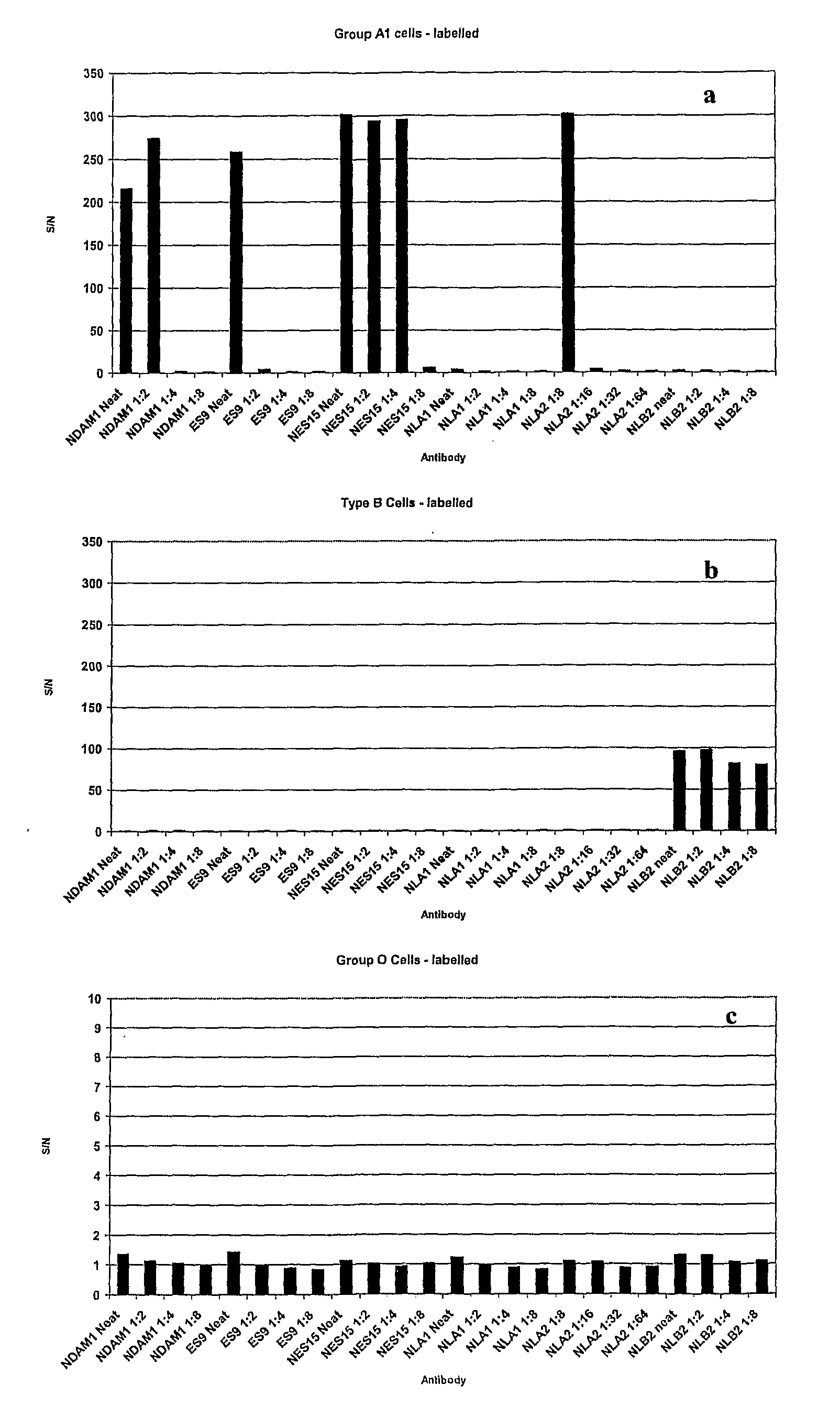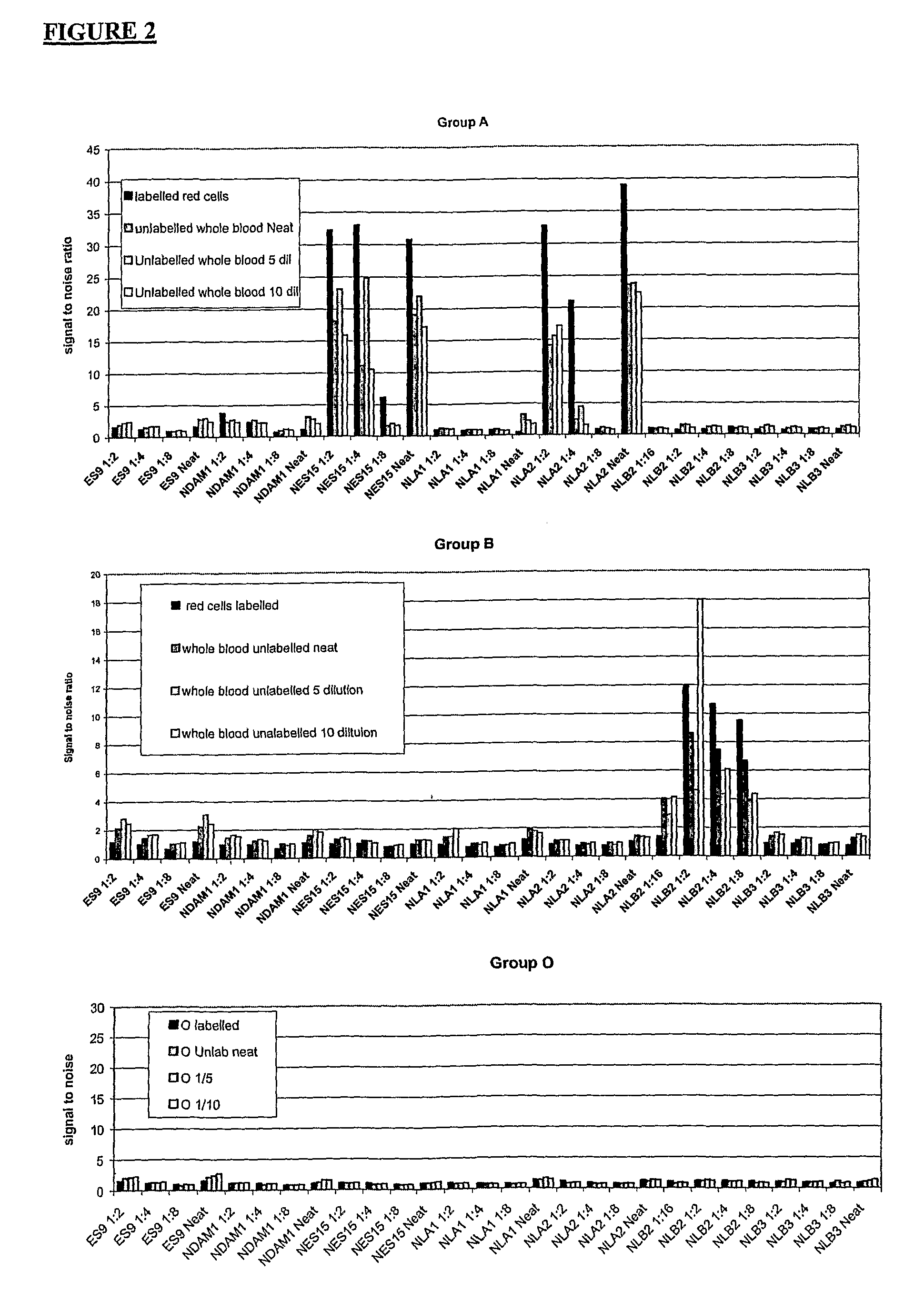Antigen Detection
a technology of antigens and fluorescent labels, applied in the field of antigen detection, can solve the problems of human error, human error, and relatively complex apparatus, and achieve the effect of reducing human error
- Summary
- Abstract
- Description
- Claims
- Application Information
AI Technical Summary
Benefits of technology
Problems solved by technology
Method used
Image
Examples
example 1
Preparation of Arrays
[0052]Epoxy silane coated slides were prepared using standard glass microscope slides from Erie Scientific. The slides were cleaned in a caustic ethanol solution comprising:
Water 420 mls
Ethanol 630 mls
[0053]for 2 hours with agitation. The slides were then rinsed twice in deionised water and centrifuged to dryness in an Eppendorf 5810R centrifuge at 1000 rpm for one minute. The slides were then placed in a solution of glycidoxypropyltriethoxy silane (1% v / v in 95:5 ethanol / water) for one hour with constant agitation. After rinsing twice in ethanol the slides were heated in an oven at 383 K for 15 minutes. After cooling, the slides were kept in a desiccated environment. Where used, other slide types were obtained from commercial sources. Gold slides from Erie Scientific or Ssens BV, Hydrogel slides from Schott or Full Moon.
[0054]Antibodies were deposited on these slides using solid pins of either 700 or 200 μm on a Microgrid II spotter from B...
example 2
Microarray Experiments
[0058]Prior to use, the arrays were blocked in Bovine Serum Albumin (BSA); this is generally considered to reduce non-specific binding to the array surface.
[0059]To block, the slides were rinsed briefly in Phosphate Buffered Saline (PBS) pH 7.0 containing 1% Bovine Serum (BSA) and 0.1% Tween 20 by vigorously submerging 10 times. They were then placed into a fresh container of PBS pH 7.0 containing 1% BSA for one hour at room temperature, with constant mixing.
[0060]The slides were rinsed briefly in PBS pH 7.0 (submerged 10 times) and centrifuged to dryness in an Eppendorf 5810R centrifuge at 1000 rpm for one minute.
[0061]Blood samples Were incubated on the array using hybridisation chambers from Schleicher and Schuell (approximate capacity: 450 μl). Blood samples were incubated on arrays for 1 hour at room temperature with constant shaking. After incubation, the hybridisation chambers were removed and the slides washed in a mixture of PBS and Tween 20 (1%) by vi...
example 3
Optimisation of Scanning Conditions
[0068]Red Blood Cells have an Absorbance Spectrum as Shown in FIG. 3.
[0069]This absorbance spectrum is typically of oxy-haemoglobin, as would be expected with native red blood cells. Since the present inventors originally thought that haemoglobin species would be responsible for the fluorescence of erythrocytes, they tried to maximise the fluorescent signal by tuning the excitation wavelength to the absorbance spectrum shown in FIG. 3. In their initial experiments, using fluorescein labelled cells, they used scanner settings for fluorescein (excitation 488 nm, emission 530 nm). Since unlabelled red blood cells absorb strongly at 420, 540 and 580 nm, they would expect one of these wavelengths to give the strongest fluorescence when excited. The peak at 420 nm has the strongest absorbance but since commercial microarray scanners do not have lasers which can excite at this wavelength, the lowest excitation available was 488 nm.
[0070]The present invent...
PUM
 Login to View More
Login to View More Abstract
Description
Claims
Application Information
 Login to View More
Login to View More - R&D
- Intellectual Property
- Life Sciences
- Materials
- Tech Scout
- Unparalleled Data Quality
- Higher Quality Content
- 60% Fewer Hallucinations
Browse by: Latest US Patents, China's latest patents, Technical Efficacy Thesaurus, Application Domain, Technology Topic, Popular Technical Reports.
© 2025 PatSnap. All rights reserved.Legal|Privacy policy|Modern Slavery Act Transparency Statement|Sitemap|About US| Contact US: help@patsnap.com



